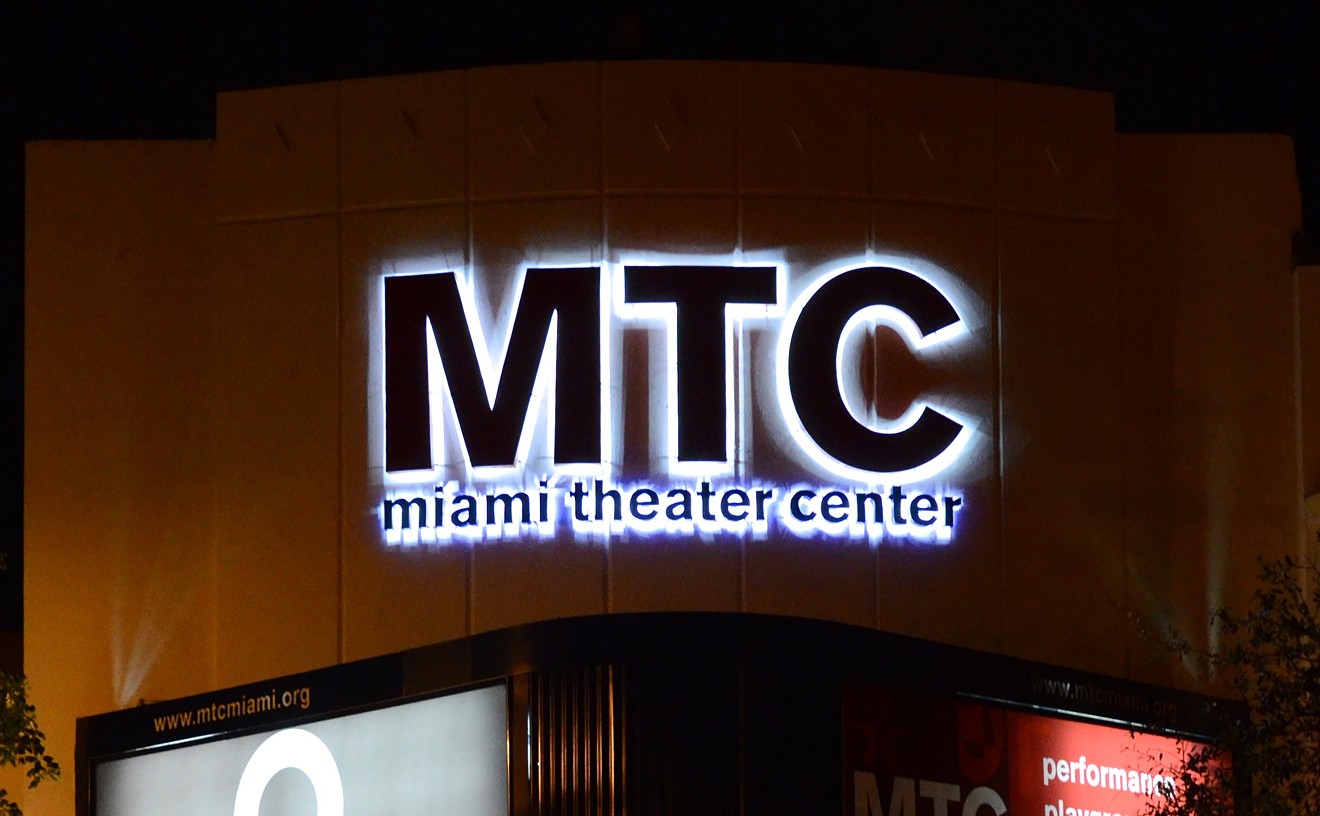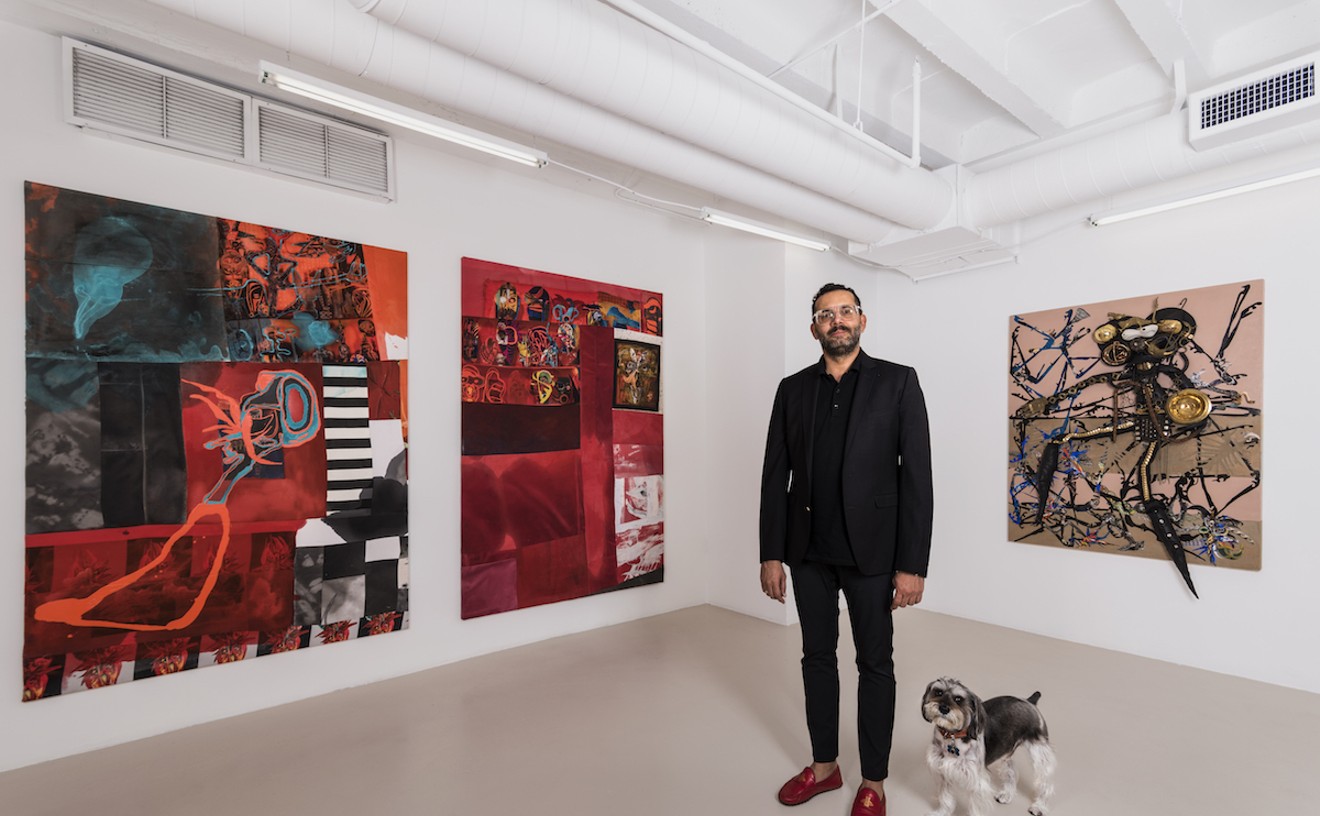Maybe the hardest thing an actor will ever have to do onstage is convey a sense of intimacy — not with the audience, but with fellow actors. You, the audience, just walked into the place, you don't know these people, you've never even seen them before, and somehow they must convey chemistry, history, and a gazillion unseen moments in the characters' unwritten pasts. In Fill Our Mouths, this happened many times. Katherine Michelle Tanner's character time-lapsed through a profound lesbian affair with Lela Elam's; Tanner's relationship with her husband, played by Brandon Morris, was solid and yet vaguely on the rocks; and when the play opened, Elam was on the verge of a tense transitional moment with her deaf girlfriend, played by Kim Ehly. Figuring out which one of these dynamics was most convincingly portrayed is impossible. Playwright Lauren Feldman didn't weigh the play down with exposition, and yet by the middle, you felt you could write these characters' entire shared histories. Whether it was Ehly playfully wiping flour across Elam's face, or Morris's loving, if occasionally bullheaded, attempts to deal with Tanner's infidelity, or the exquisitely subtle signs we were given that Tanner and Elam's relationship was blossoming into something more than platonic — any given 10 minutes of Fill Our Mouths was filled with enough smartly acted humanity to convince you that you'd been with these people from the beginning.
Best Acting Ensemble
The Cast of Fill Our Mouths
- 8567 Coral Way, Miami, 33155 Map
- 305-443-5909
- www.new-theatre.org
Best Activity to Do While Intoxicated
Hashing
It might seem a little counterintuitive at first: drink, then run — and then drink some more, run a bit, and finish it all off with a few "down-downs," which consist, oh yes, of drinking (teetotalers need not worry — water is okay too). It's called hashing, and, crazy as it sounds, it's a worldwide sport, with chapters everywhere from Boca to Baghdad. The premise is fairly simple: Every week, hashers gather in a different location and send out a "hare" to lay a trail — using chalk, flour, toilet paper, whatever — for the rest of the hashers to try to follow, shouting the customary "On, on!" to show they're on track. The wily hare, not wishing to be caught, lays various ingenious traps for the hashers in pursuit. It's not easy, but when things get sticky, the hare stops everyone in their tracks with — what else — a hidden stockpile of beer. Afterward, everybody gathers in a raucous circle to sing songs, make merry, and impose down-downs on each other. Although Miami has yet to claim a hash all its own, the Fort Lauderdale/Miami Hashers are always nearby, and they're a hell of a nice group of people to spend a Monday night getting sloshed with. For information about the next hash, call the hotline. On, on!
Best Actor
Erik Fabregat for Animals & Plants

Loud but not too loud, funny but no scenery-chewer, smart but not showy, and crazily, bodily committed to his roles, Fabregat is an actor's actor. He makes bad plays good, good plays great, and great plays transcendent. Animals & Plants was an example of the last, and Fabregat deserves much of the credit. There was nothing very notable or obvious about his character: As an awkward, small-time dope dealer named Dantley, he was a little dumb, a little shy, and extremely unsure of himself and his place in the world. He walked through the world of Mad Cat's stage as if every unopened door concealed either a kiss or a pie in the face. We found ourselves rooting for him like he was a stand-in for all the lost, scared bits of ourselves we've tried to throw out over the years. His great achievement was allowing audiences full of circumscribed individuals to see themselves in a character to whom they bore no resemblance, and whom they would, in the real world, ignore without a second thought.
- 9806 NE Second Ave., Miami Shores, 33138 Map
- 305-751-9550
- mtcmiami.org
Best Actress
Lela Elam for In the Continuum
Lela Elam is probably the most intense working actor in Florida. Her characters are lived-in, internally consistent, and fiercely themselves; no two are alike, and not one is much like anybody you've ever met. Which is why Elam was also a close contender for Best Actress for her portrayal of a hard-of-hearing, free-spirited lesbian in New Theatre's Fill Our Mouths, as well for her few moments onstage at The 24 Hour Theatre Project as a beauty-obsessed mall-rat surgery-freak with no morals. But she had more lines in In the Continuum than in either of those pieces (it was a two-woman show), more time to cover her character with layers and fill her with life. In the Continuum found Elam portraying a Los Angeles teenager impregnated and infected with HIV by her love-'em-and-leave-'em high school star athlete boyfriend. What audiences found in her was a girl with eyes wide open, forced to witness her own life and dreams and future being sold on the cheap. She overcooked nothing yet held nothing back, and the performance was devastating. People filing out of the big theater at The Biltmore didn't know what to say to each other.
- 1200 Anastasia Ave., Coral Gables, 33134 Map
- 305-446-1116
- www.gablestage.org
Best Ad for Miami Made Elsewhere
CSI: Miami
Every Monday night, tens of thousands of people in flyover states tune into one of the most popular crime dramas on television today: CSI: Miami. Although the show is about a group of intrepid and intelligent crime fighters here in the Magic City, the real star is Miami. Shots of sun-dappled beaches, lush and glowing tropical foliage, and skyscrapers that glitter in the white-hot sun entice the pasty hordes to our city. Trouble is, many of the scenes aren't filmed here. They're shot in California. No matter. It's hard not to watch the show and think, I want to live in that subtropical paradise. Wherever that is.
Best AM Radio Personality
Mike Andrews
If "soca in me veins, soca in me blood" is blaring through your car windows and you're threatening to pull over and do the soca wine, it can only mean it's Saturday afternoon and time again for Mike Andrews's Caribbean Connection. Andrews has been host of the most energetic show on South Florida airwaves for about the past 20 years. When he's not giving you the latest sports scores and reading the most-talked-about news items from his native Trinidad, Andrews is spinning popular sides from the island country's finest musicians. It's not all infectious soca, though. You'll get an education in calypso, parang, chutney, steelband, and other musical styles from the Caribbean. And if you're really lucky, you'll catch Andrews singing over those Carnival tapes smuggled in from Trinidad.
Best Art Gallery
David Castillo Gallery

David Castillo's work ethic would have put the Puritans to shame. The young dealer often clocks 14-hour days, out-hustling competitors and regularly organizing gallery and museum shows for his modest stable of emerging and midcareer artists. The Yale grad has been in the business 13 years, successfully trafficking in the secondary modern art market with the museum trade. But it's in his pristine Wynwood gallery where Castillo is leaving heavy footprints on the local scene. From Pepe Mar's impish cut-up three-dimensional collages, riffing on pop culture artifice, to Andrew Guenther's psychedelic lobster-clawed space aliens, to Leyden Rodriguez-Casanova's brainy excavations of contemporary domestic life, Castillo's shows have been consummately curated and first-rate. It comes as no surprise that one of Miami's sharpest talents, Glexis Novoa, has recently entered Castillo's budding stable, considering the gallery has been swamped by more than 3,000 artist submissions since opening in 2005.
- 3930 NE Second Ave., Miami, 33127 Map
- 305-573-8110
- davidcastillogallery.com
Best Art Museum
Miami Art Museum
From its informative Morning Lecture Series on the monumental figures of 20th-century architecture, to the breathtaking Herzog and de Meuron design for Museum Park, Miami Art Museum (MAM) finds itself swept up in a whirlwind of buzz. MAM also mounted one of its most memorable exhibition seasons in years. "Tamayo: A Modern Icon Reinterpreted" marked the Mexican master's first major U.S. exhibition in 30 years. It featured nearly 100 of Rufino Tamayo's paintings, many not shown publicly for decades, offering an in-depth examination of a prolific career spanning 70 years. "The Killing Machine and Other Stories 1995-2007," by Canadian artists Janet Cardiff and George Bures Miller, marked the first entry in the ambitious MAC @ MAM sweeps. The sprawling exhibit featured 11 multimedia installations mixing opera, art films, and literature with B movies, rock and roll, and radio broadcasts. MAM's current exhibit, "Wifredo Lam in North America," herds more than 80 of the Chinese/Afro-Cuban master's works, more than a quarter-century after the artist's death, finally giving the controversial Lam his due in the Big Mango. Throw in the museum's thoughtful educational and family programming and it adds up to an enticing recipe for stampedes all year.
Best Attempt to Convert Nonbelievers
Bank of Heaven
You're lying in bed one early Sunday, head under the covers, when a group of chirpy Christians knocks on your door. After spotting them through the peephole, you cross your fingers and pray they shove off. Hell-bent on salvation, they keep banging away, eager to bring the pagan on the wrong side of the threshold into Jesus' fold. Before giving up, the anonymous evangelists slip a check from the "Bank of Heaven" under the door. It reads, "Pay to the order of everyone without The Lord Jesus Christ." The sum for those unwilling to bend their knees for the glory of redemption? "Eternal Death — Torment Forever in the Lake of Fire."
Best Basel Headline Grab by a Local Artist
Maite Josune
When Baselphrenia grips the Big Orange each year, the moonberries creep out of the woodwork, eager to add some homespun flair to the planet's greatest arts confab. Some peddle nickel bags of art and push shopping carts full of ephemeral trash across town, others splooge art swells with the sodden contents of a four-foot-long pneumatic pink-foam pecker. But Maite Josune froze traffic on NW Second Avenue and 23rd Street in Wynwood during the fair with her car-wreck-cum-jungle installation, which she christened "Mind the Snails." The nervy Josune salvaged a 1995 Mazda MX-3; slathered it in acidy cranberry, cobalt, and lemon yellow hues; and plopped it down in front of Art Miami for maximum media exposure. She covered the jalopy with huge white and green snails as symbols that "no artist should be left behind." To crown her achievement, Josune planted ficus, ferns, and palms from her Kendall garden in the car's trunk, bringing a loopy dash of suburbia to dreary art district. The homeless loved it, sleeping in her vehicle long after chichi art patrons evacuated the area at nightfall. Josune's problems arose when neighboring galleries called the cops to complain. Miami Police ticketed and impounded the tagless art piece, apparently unimpressed by the enterprising artist's conceptual clunker.





